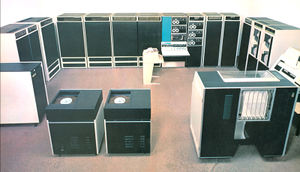KA10
From Computer History Wiki
| KA10 | |
| Manufacturer: | Digital Equipment Corporation |
|---|---|
| Architecture: | PDP-10 |
| Year Design Started: | January, 1966 |
| Year First Shipped: | September, 1967 |
| Form Factor: | mainframe |
| Word Size: | 36 bits |
| Logic Type: | silicon transistors and diodes |
| Design Type: | asynchronous with hardware subroutines |
| Clock Speed: | 3 μsec (approximately - different instructions take different amounts of time, the CPU is not synchronous) |
| Memory Speed: | 1.0 μsec (fast), 1.8 μsec (slow) |
| Physical Address Size: | 18 bits (normal), 19/20 (ITS paging box), ?? (TENEX paging box) |
| Virtual Address Size: | 18 bits |
| Memory Management: | dual base and bounds register pairs (non-customized machines) |
| Operating System: | Monitor, ITS, WAITS, TENEX |
| Predecessor(s): | PDP-6 |
| Successor(s): | KI10 |
| Price: | US$150K (CPU), US$300-700K (system) |

B-series FLIP CHIP used in the KA10 CPU
The KA10 was the first generation of PDP-10 processors (themselves, exact re-implementations of the earlier PDP-6 architecture). It was built out of discrete transistors, on short single FLIP CHIP cards.
It had hardware support for time-sharing (two modes, 'User' and 'Executive'), as well as base and bounds memory management hardware. These were used in the first DECsystem-10 models, running TOPS-10.
It was also the machine on which the ITS and TENEX operating systems were developed, after the machines were modified to provide paging.
